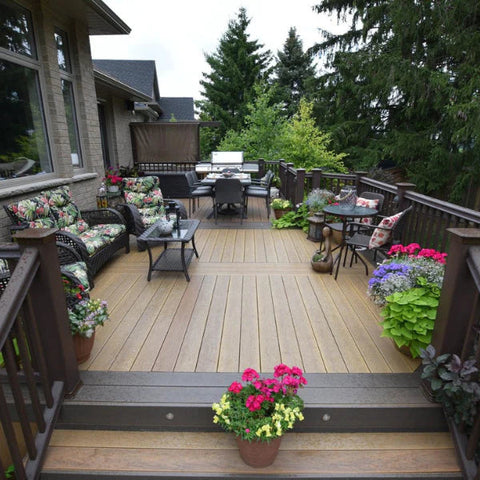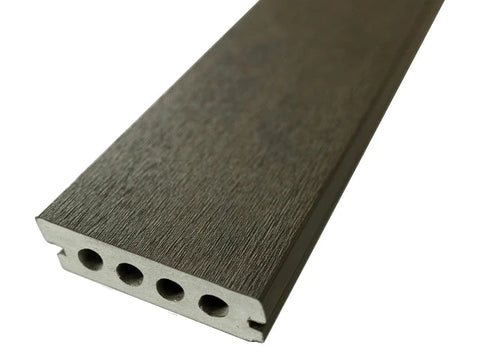When it comes to building a beautiful and durable deck, one of the best choices you can make is to go with composite decking materials. Composite decking offers a range of benefits that make it a popular choice for homeowners and contractors alike. In this comprehensive guide, we will explore everything you need to know about composite decking, from its advantages to the various types available on the market.
Why Choose Composite Decking?
Before delving into the different types of composite decking, let's understand why you might want to choose composite materials for your deck in the first place.
- Durability: Composite decking is known for its exceptional durability. Unlike wood, it doesn't rot, warp, splinter, or decay when exposed to the elements. This means your composite deck will maintain its beauty and structural integrity for years to come.
- Low Maintenance: One of the biggest advantages of composite decking is its minimal maintenance requirements. You won't need to stain, seal, or paint your deck regularly. A simple periodic cleaning with soap and water will keep it looking great.
- Longevity: Most composite decking products come with long warranties, often ranging from 20 to 25 years or even more. This means you can enjoy your deck without worrying about replacement or extensive repairs for a long time.
- Aesthetics: Composite decking comes in a wide range of colors, textures, and finishes, allowing you to achieve the look you desire for your outdoor space. It can mimic the appearance of natural wood while offering superior performance.
- Environmentally Friendly: Many composite decking materials are made from recycled materials, such as plastic bags and sawdust. Choosing composite helps reduce the demand for virgin timber and promotes sustainable building practices.
- Safety: Composite decking is slip-resistant, making it a safer option for areas around pools and in regions prone to rain or snow.
Now that we've established the benefits of composite decking, let's delve into the different types available:
1. Capped Composite Decking
Capped composite decking is the most popular and widely used type of composite decking material. It is known for its exceptional durability and resistance to the elements. The term "capped" refers to a protective polymer shell that encapsulates the core of the board, providing extra protection against moisture, stains, and fading.
Advantages of Capped Composite Decking:
- High Durability: The protective cap makes capped composite decking highly resistant to scratches, stains, and fading, ensuring it retains its color and texture for years.
- Low Maintenance: Capped composite decking is easy to clean, and you won't need to worry about staining or sealing it.
- Realistic Wood Look: Many capped composite boards are designed to closely mimic the look of natural wood, with realistic wood grain patterns and textures.
- Mold and Mildew Resistance: The cap prevents moisture infiltration, making capped composite decking highly resistant to mold and mildew growth.
2. Uncapped Composite Decking
Uncapped composite decking lacks the protective polymer shell found in capped composite boards. While it offers many of the benefits of composite decking, it may require slightly more maintenance and can be more prone to staining and fading over time. However, it is generally more affordable than capped options.
Advantages of Uncapped Composite Decking:
- Cost-Effective: Uncapped composite decking is often more budget-friendly than capped options, making it a good choice for those looking to save on upfront costs.
- Low Maintenance: While not as resistant to staining and fading as capped composite, uncapped composite decking still requires significantly less maintenance than wood.
- Environmentally Friendly: Many uncapped composite boards are made from recycled materials, contributing to sustainability efforts.
- Realistic Wood Look: Like capped composites, uncapped boards can closely resemble the appearance of natural wood.
3. PVC (Polyvinyl Chloride) Decking

PVC (Polyvinyl Chloride) Decking is a popular choice for outdoor spaces due to its durability and low maintenance requirements. It's a synthetic material that resists rot, mold, and insect damage, making it ideal for decks that withstand the elements year-round. Clubhouse Premium PVC Decking and Lanai Premium PVC Decking are standout options in this category.
Clubhouse Premium PVC Decking boasts a luxurious aesthetic, mimicking the look of natural wood while offering the benefits of PVC. Its rich colors and wood-grain texture add sophistication to any outdoor setting. Plus, it's designed for minimal upkeep, ensuring your deck remains beautiful for years to come.
Lanai Premium PVC Decking, on the other hand, combines modern aesthetics with PVC's durability. With an array of contemporary colors and a sleek, smooth finish, Lanai Decking elevates the visual appeal of outdoor spaces while requiring little maintenance.
Both Clubhouse and Lanai Premium PVC Decking options provide homeowners with an excellent choice for durable, visually appealing decks that stand the test of time.
Advantages of PVC Decking:
- Outstanding Durability: PVC decking is virtually impervious to moisture, making it an excellent choice for areas with heavy rainfall or near water bodies.
- Low Maintenance: Like composite decking, PVC decking requires minimal maintenance, with no need for staining, sealing, or painting.
- Stain Resistance: PVC decking is highly resistant to stains, including those from food and beverages.
- Longevity: PVC decking often comes with extensive warranties, ensuring a long lifespan for your deck.
- Lightweight: PVC boards are typically lighter than composite or wood, making them easier to handle during installation.
4. Composite Wood-Plastic Decking
Composite wood-plastic decking is a type of composite decking that combines wood fibers or sawdust with plastic. This combination results in a decking material that is more natural in appearance and texture while still offering the durability and low maintenance benefits of composite decking.
Advantages of Composite Wood-Plastic Decking:
- Natural Appearance: This type of composite decking often closely resembles the appearance of real wood, with a warm and authentic look.
- Durability: Composite wood-plastic decking is resistant to rot, insects, and decay, just like other composite materials.
- Low Maintenance: It requires minimal maintenance, with no need for staining or sealing.
- Eco-Friendly: Many composite wood-plastic decking products use recycled materials in their construction.
5. Hollow vs. Solid Composite Decking
Hollow Composite Decking: Hollow boards are lightweight and cost-effective. They consist of a honeycomb-like structure, making them lighter without sacrificing strength. They're ideal for projects where weight is a concern or for those on a tighter budget. Hollow boards are also easier to install due to their reduced weight.They are also quite structurally sound and can hold over 1000 lbs.

Solid Composite Decking: Solid boards, like TruNorth Solid Core Composite Decking, are denser and heavier, resembling traditional wood boards in terms of weight and feel. They offer superior strength and durability, making them an excellent choice for high-traffic areas or locations with harsh weather conditions. Solid composite decking tends to have a more authentic appearance, with deep wood-grain patterns, and they're less prone to flexing. They also come in a square edge profile, allowing you to use it for trim and stairs. You can mix and match both hollow and solid as the color palette is shared.

TruNorth Solid Core Composite Decking is a premium option in the solid category. It combines the aesthetics of natural wood with the durability and low maintenance of composite materials. With TruNorth, you get a long-lasting, fade-resistant deck that retains its beauty without the need for staining or sealing.
Ultimately, the choice between hollow and solid composite decking depends on your specific needs, budget, and aesthetic preferences. Both offer an array of benefits, but solid composite decking, especially premium options like TruNorth®, tends to be favored for its robustness and timeless appeal.
Advantages of Hollow Composite Decking:
- Lighter Weight: Hollow boards are lighter, which can make installation easier, especially for DIYers.
- Cooler Surface: They tend to stay cooler in the sun compared to solid boards, making them more comfortable to walk on barefoot.
- Cost-Effective: Hollow boards are often less expensive than solid boards.
Advantages of Solid Composite Decking:
- Sturdier: Solid boards are more rigid
- Realistic Feel: They often have a more realistic wood-like feel underfoot.
- Reduced Noise: Solid boards tend to be quieter underfoot, with less echoing or hollow-sounding noise.
Choosing the Right Composite Decking
Now that you're familiar with the different types of composite decking, how do you go about choosing the right one for your project? Here are some key factors to consider:
- Budget: Determine your budget for the project. This will help you narrow down your options, as different types of composite decking come at varying price points.
- Climate: Consider your local climate. If you live in an area with extreme heat, cold, or heavy rainfall, you'll want a decking material that can withstand these conditions.
- Aesthetics: Think about the look you want to achieve with your deck. Do you prefer a natural wood appearance, or are you open to a more contemporary style?
- Maintenance: Assess how much time and effort you're willing to invest in deck maintenance. If you want a truly low-maintenance option, capped composite or PVC decking might be your best bet.
- Usage: Consider how you plan to use your deck. Will it see heavy foot traffic? Is it near a pool or hot tub? Your deck's intended use will impact your choice.
- Color and Texture: Explore the color and texture options available in our gallery within the type of composite decking you choose. Some boards offer a wide range of choices.
- Warranty: Look into the warranties offered by different manufacturers. A longer warranty can provide peace of mind regarding the longevity of your deck.
- Installation: Consider whether you'll be installing the deck yourself or hiring a professional. Some types of composite decking may be easier for DIY projects.
Maintenance Tips for Composite Decking
Regardless of the type of composite decking you choose, here are some general maintenance tips to keep your deck in top shape:
- Regular Cleaning: Periodically clean your deck with mild soap and water to remove dirt, grime, and pollen.
- Avoid Harsh Cleaners: Avoid using harsh chemicals or pressure washers, as they can damage the surface of the decking.
- Remove Stains Promptly: Address any spills or stains promptly to prevent them from setting into the decking material.
- Use Mats and Furniture Pads: Place mats under outdoor furniture and use furniture pads to prevent scratches and scuffs.
- Inspect for Damage: Periodically inspect your deck for any signs of damage, such as loose boards or damaged fasteners, and make repairs as needed.
- Trim Nearby Trees and Plants: Trim back trees and plants that may deposit leaves, sap, or other debris onto your deck to reduce cleaning requirements.
Conclusion
Choosing the right composite decking material for your outdoor space is a crucial decision that can greatly enhance your home's aesthetics, value, and functionality. Whether you opt for capped composite, uncapped composite, PVC, composite wood-plastic, hollow, or solid decking, each type has its unique advantages to offer.
Consider your budget, climate, desired aesthetics, maintenance preferences, and intended use when making your selection. Whichever type you choose, you can enjoy a beautiful, low-maintenance deck that will provide years of outdoor enjoyment. Remember to follow proper maintenance practices to ensure your composite deck continues to look and perform its best. With the right choice and care, your composite decking will become a beloved feature of your outdoor living space for years to come.


